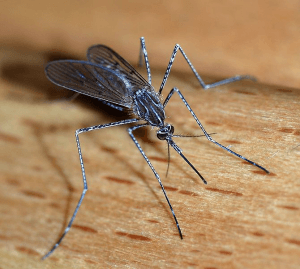
The blood engorged fossil mosquito most closely resembles the current subfamily Culicinae and the subgenera Climaclura and Culicella. Source: http://en.wikipedia.org/wiki/File:Mosquito_2007- 2.jpg
Dale Greenwalt and his research team have discovered a rare 46 million year old fossil of a blood engorged mosquito (1). The fossil, collected from northwestern Montana, is one of a few fossils in which scientists have identified hemoglobin derived porphyrins. Porphyrins are a naturally occurring group of organic aromatic compounds, of which heme is the most well-known.
Fossil records of hematophagous or blood feeding insects are poor and biased towards species that live near resin-producing trees and are as a result preserved in amber. Contrary to a popular misconception from the film Jurassic Park, mosquitoes are 70% of the time found in shale, not amber, and their fossils are generally very rare.
Also, most hematophagous specimens are identified based on their similarities to existing hematophagous insects. Before this recent discovery, only four other cases had direct evidence of hematophagy and even in those cases, the evidence was limited to the discovery of Plasmodium and Trypanosoma, microbial parasites that live in the intestines of blood sucking insects, near or in the fossils.
In this case, the researchers focused on proving the presence of heme, the red pigment in blood to prove hematophagy. As iron stabilized heme consists of both iron and protoporphyrin, the researchers set out to prove the presence of both. To confirm the presence of iron in the fossil, they used energy dispersive X-ray spectroscopy (EDS).
Greenwalt and his team also used EDS on the female mosquito’s thorax and abdomen as well as on the surrounding shale and on a male mosquito. The researchers needed an EDS of the shale to distinguish between higher levels of iron in the female mosquito’s abdomen from the iron in the surrounding shale formation. The male mosquito was also analyzed as male mosquitoes do not take blood meals, so its EDS can serve as a control for the female mosquito’s EDS.
They found that the abdomen of the female mosquito fossil had eight times the weight percent value for iron (8.97%) than the thorax of the female and the abdomen of the male mosquito. An EDS of purified pig hemoglobin has a weight percent value for iron of 0.33% and human hemoglobin has 0.34%. The researchers rationalized that the percentage of iron in the fossils are much higher as other less stable components decayed and were removed over time. Analysis of the surrounding shale also revealed much higher iron values in the female abdomen than in the surrounding rock.
Greenwalt also used time of flight secondary ion mass spectrometry (ToF-SIMS) to prove the presence of heme. Analysis of the female and male mosquito fossils using ToF-SIMS found that the abdomen of the female was similar to spectrums of purified hemoglobin and significantly different from spectrums of the area surrounding the fossil, confirming the specimen as a blood engorged mosquito.
The blood engorged mosquito fossil extends the behavior of hematophagy 46 million years into the past for their family of insects.
1. D. E. Greenwalt et al., Proc. Natl. Acad. Sci. U.S.A. Available at http://www.pnas.org/content/early/2013/10/08/1310885110.short?rss=1%20 (18 October 2013)
Leave a Reply